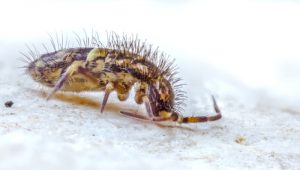Springtails in Damp Areas
By Chris Williams on October 28, 2011.
Q. I found a bunch of bugs under my kitchen sink. You can barely see them but they jump! I don’t think they’re fleas because they’re light-colored and our dog doesn’t seem to have any fleas. He gets treated regularly. I sprayed the bugs about a week ago, but they’re still there. What do you think they could be and how do I get rid of them?
A. They’re obviously not fleas. Not only are they the wrong color but there’s no reason that fleas would be under your kitchen sink. There is a reason that insects called springtails would be under your sink though.
Springtails (also called Collembola) are one of our so-called “moisture pests” because they are associated with anything overly damp. They come in a range of colors and sizes but all are very small, about 1/16-inch. As you know, they will jump when disturbed using a spring-like appendage on their abdomen called a furcula. They don’t bite or sting.
 Springtails are a very common insect (but rarely noticed) outside in soil, under bark, and in leaf mold where they feed mostly on fungus and rotting plant material. Sometimes they move indoors as outside sites dry out. Usually they don’t survive long in the drier indoor atmosphere. But if there is a moisture problem—a water leak, for example, or very high humidity, they can survive and build up to high numbers inside. I bet you have a slow plumbing leak under your kitchen sink that is keeping the wood or particleboard there damp. The springtails are feeding on mold growing under your sink, which you may not even be able to see.
Springtails are a very common insect (but rarely noticed) outside in soil, under bark, and in leaf mold where they feed mostly on fungus and rotting plant material. Sometimes they move indoors as outside sites dry out. Usually they don’t survive long in the drier indoor atmosphere. But if there is a moisture problem—a water leak, for example, or very high humidity, they can survive and build up to high numbers inside. I bet you have a slow plumbing leak under your kitchen sink that is keeping the wood or particleboard there damp. The springtails are feeding on mold growing under your sink, which you may not even be able to see.
These are some typical indoor springtail infestation sites: damp basements and crawlspaces, damp wall voids, plumbing leaks around sinks, floor drains, overwatered house plants, leaky patio doors, sweating pipes, moldy mattresses or stuffed furniture. Springtails can also be a problem in newly constructed buildings because of “green” building materials and wet plaster. As the building gradually dries, the springtails will leave or die.
The key to springtail control is to dry out the area where they are found. Springtails need moisture and high humidity to survive. In some situations, the high moisture is temporary and the area will dry out on its own. In your case, however, your first step is probably to repair a plumbing leak. Then vacuum up the springtails. Wash the area with a mild bleach solution to kill any mold, and let the area under the sink dry completely. For a small space like that, keep the cabinet doors open and put a fan or small space heater in front, or even use a hair dryer to help dry out the under-sink area.
When springtail populations are heavy or if the area infested is extensive and can’t be easily dried out (like damp wall voids), a pest control company can treat the area with an insecticide. In your case, however, since it sounds like you have a small infestation that is compartmentalized, you should be able to control the springtails on your own without insecticides.